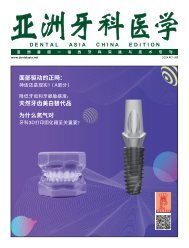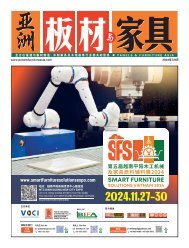Dental Asia May/June 2020
For more than two decades, Dental Asia is the premium journal in linking dental innovators and manufacturers to its rightful audience. We devote ourselves in showcasing the latest dental technology and share evidence-based clinical philosophies to serve as an educational platform to dental professionals. Our combined portfolio of print and digital media also allows us to reach a wider market and secure our position as the leading dental media in the Asia Pacific region while facilitating global interactions among our readers.
For more than two decades, Dental Asia is the premium journal in linking dental innovators
and manufacturers to its rightful audience. We devote ourselves in showcasing the latest dental technology and share evidence-based clinical philosophies to serve as an educational platform to dental professionals. Our combined portfolio of print and digital media also allows us to reach a wider market and secure our position as the leading dental media in the Asia Pacific region while facilitating global interactions among our readers.
You also want an ePaper? Increase the reach of your titles
YUMPU automatically turns print PDFs into web optimized ePapers that Google loves.
Clinical Feature<br />
Rationale of the new technique<br />
This technique was actually inspired by the<br />
ability of Bendistal Pliers to place lasting<br />
bends and activate tied super elastic<br />
archwires intraorally. Resiliency of super<br />
elastic wires provided light force delivery<br />
and allowed bending tied archwires without<br />
breaking adjacent brackets. Also the stability<br />
of bends ensures consistency of force<br />
delivery over the long range of activation<br />
those wires are famous for. The key to the<br />
success of this technique is its simple clinical<br />
applicability, its convenience and time<br />
savings, besides enabling orthodontists to<br />
customise the number and locations of the<br />
intrusive V-bends on tied archwires.<br />
Mechanical considerations of the<br />
V-bends<br />
1. It is well known that a V-bend on any<br />
orthodontic wire creates two moments equal<br />
in magnitude and opposite in directions<br />
acting on teeth in both sides of that bend<br />
(Fig. 4a). The labially directed moment<br />
acting on teeth segment anterior to the<br />
V-bend is counteracted by an equal and<br />
posteriorly directed moment (side effect)<br />
on teeth segment posterior to that bend.<br />
Analysing those moments to the couple<br />
of forces causing them, we see intrusion<br />
of the furthest teeth on both sides of the<br />
V-bend, and extrusion of teeth closest to<br />
that bend (Fig. 4b). The intrusion effect and<br />
the extrusion side effect resulting from this<br />
V-bend technique work favourably to open<br />
the deep overbite.<br />
Fig. 4a: Diagram showing analysis of the force<br />
system created by V-bends located between<br />
canine and first premolar. To bring the system into<br />
equilibrium, anterior moment M1 must be equal to<br />
posterior moment M2<br />
Fig. 4b: Shows the intrusion and extrusion effects of<br />
both moments acting on tooth segments located on<br />
both sides of the bend<br />
2. The apically directed forces applied<br />
through facial brackets of anterior teeth<br />
intrude them and cause them to flare<br />
because the force line passes facial to<br />
their centre of resistance creating a labially<br />
directed moment. Such flaring can be<br />
controlled with elastomeric power chain<br />
extending from one upper molar to the other.<br />
3. In maxillary first premolar extraction<br />
patients, posterior segment consisting of<br />
first molars and second premolars provides<br />
an anchorage of eight roots, to intrude the<br />
six roots of the anterior teeth segment.<br />
Posterior teeth anchorage can be further<br />
strengthened by adding both maxillary<br />
second molars that increase number of<br />
anchor roots to 14, if minimal side effect<br />
is indicated. The anterior teeth intrusion is<br />
elicited by the vertical component of force of<br />
the anterior clockwise moment causing the<br />
bite to open. Clinician can decide whether to<br />
prevent or take advantage of the extrusive<br />
side effect on teeth close to both sides of the<br />
V-bend that help opening the deep overbite<br />
as well in Fig. 4.<br />
4. Although intrusion of the furthest molars<br />
of posterior segments may be an unwelcome<br />
side effect 23 , it is advantageous since the<br />
apically-directed force acting buccally to<br />
molar’s centre of resistance intrudes their<br />
buccal cusps and extrudes their lingual<br />
cusps. This very side effect becomes a<br />
favourable and indispensable step to<br />
disengage upper and lower molar cusps that<br />
simplifies cross-bite correction by routine<br />
bend adjustments. It actually constitutes the<br />
core of the rationale for another technique<br />
to correct cross bites.<br />
Clinical technique and wire sequence<br />
Traditional intrusive appliance designs<br />
and springs made of stainless-steel wires<br />
required long prefabrication time, frequent<br />
adjustments, and high patient cooperation<br />
over long treatment times. Although V-bends<br />
on stainless steel wires were already known<br />
to intrude teeth, their relative stiffness<br />
and short range of activation limited their<br />
efficiency and clinical application.<br />
Bendistal Pliers provides a clinically simple<br />
way of placing V-bends on titanium archwires<br />
to ensure light and consistent intrusive<br />
force delivery. To master this technique,<br />
orthodontists must have a good background<br />
in creating the bite opening force system<br />
through placing V-bends that incidentally<br />
conform to segmental formats.<br />
This technique can be started as early as<br />
when the initial small-sized 0.016” NiTi<br />
wire finishes its sole role in preliminary<br />
teeth alignment. Instead of discarding<br />
this wire, placing V-bends on it distal to<br />
both canines will rejuvenate this wire,<br />
Fig. 5a: Right intraoral view of 100% severe overbite<br />
before treatment<br />
Fig. 5b: During treatment with the intrusive V-Bends<br />
in both dental arches<br />
34<br />
DENTAL ASIA MAY / JUNE <strong>2020</strong>


















